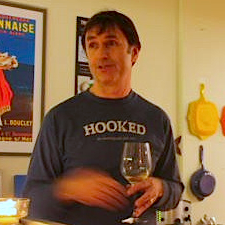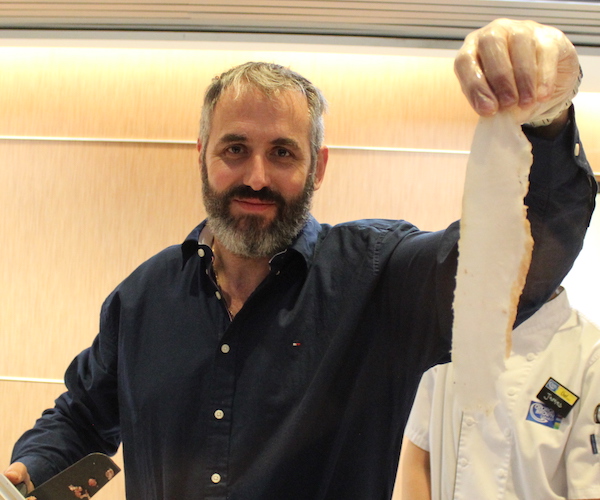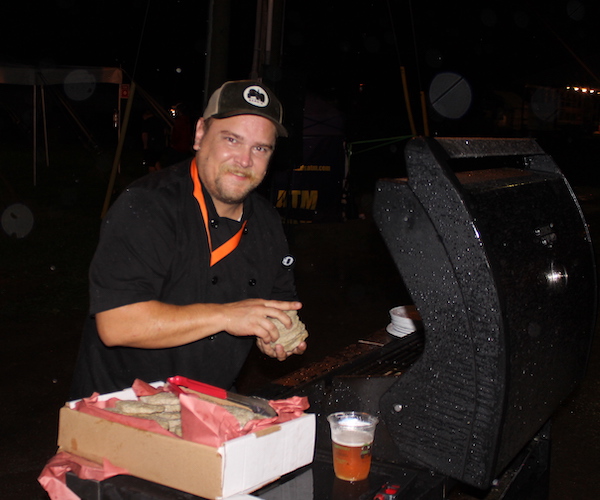By Jamie Drummond
Blind Wine Tasting: The blind tasting of wine involves tasting and evaluation of wines without any knowledge of their identities. This is done because knowing the identity of a wine easily prejudices tasters for or against it because of its geographic origin, price, reputation, or other considerations.

Blind Tasting #434 by Pablo Gad
Despite having been working as a Sommelier for nigh on 17 years, I have always been rather painfully cognisant of the sad fact that I have certain inherent failings when it comes to blind tasting.
With this in mind, it was with a certain amount of trepidation that around two weeks ago I made the (foolhardy?) decision to enter Toronto’s Wine Tasting Challenge for the third consecutive year. The annual Challenge, which is now in its sixth year, was created by The Renaissance Project and in 2005 Brock University’s Cool Climate Oenology and Viticulture Institute became the organizing/presenting body. Open to both professionals and amateurs, the Challenge is the largest of its kind in North America. Interestingly, the Challenge has no entry fees, and with a prize purse in excess of $100,000 you can be sure that the event is annually oversubscribed, with over 250 eager wine geeks sniffing, swirling and spitting this year.

Blind Tasting #199 by Pablo Gad
I arrived at the 32nd floor of the Four Seasons Hotel in downtown Toronto in quite the state. Having adhered to my self-imposed mandate of using my bicycle to propel me everywhere in this city, I had made a slight miscalculation regarding just how long it would take me took get from deepest, darkest Parkdale to Yorkville upon two wheels. The Challenge is always executed with military-like precision by a group of outstanding volunteers, and so I was acutely aware that if I were not to make it there for my allotted 3pm slot I would simply not be admitted to the 2009 competition. With burning lungs, a solid sheet of perspiration and a rather red face, I was the last competitor to be admitted to the competition venue.

Blind Tasting #454 by Pablo Gad
The room was almost silent save the pleasant understated clinking of Riedel stemware and the muted and yet guttural sounds of vinous expectoration. Sitting at the back of the room, I could see my fellow competitors; heads down, noses in glasses, faces locked in the classical throes of academic concentrations. I looked out the wide windows of the room, surveying the panorama of Toronto north of the Four Seasons, attempting to calm my body, mind and olfactory organs, for the evaluation that lay ahead. Feeling a little hot after my exertions I peeled off my winter coat whilst remaining seated. Unfortunately at that same moment a young gentleman was directly behind me with a silver tray containing my first blind flight of the day. In solid agreement with Galileo Galilei’s Pisa hypothesis, said silver tray, seven Riedel glasses and seven mysterious wines descended to the floor in a cacophony of intrusive volume. As an entire room full of serious-faced oenophiles turned to inspect the gravity of the situation I realized that this was certainly not the most auspicious of starts to my Wine Tasting Challenge 2009.

Blind Tasting #576 by Pablo Gad
So, the perennial question: Is the art/process of blind tasting an intellectual exercise or a wily parlour trick, a cad’s game of chance? Speaking of cads, many is the time that fellows have caught me off-guards at the nether region of a particularly debauched dinner party, forcing a half wine glass of some unknown origin beneath my nose and slurring “Sho… what do ya think thish ish Mishter Somalian?”. I have to admit that despite my opening admission, upon the rare occasion I have been known to rather theatrically examine the proffered wine, take a true leap of olfactory faith and more or less nail the exact grape(s), origins, vintner and vintage of the juice in question (much to the rapturous applause of the assembled audience and the chagrin of my sly challenger). But if the truth be told, those moments are few and far between. Way too few and far between for me to ever think of myself as a good blind taster.

Blind Tasting #129 by Pablo Gad
Richard Healy, Sommelier at Toronto’s Wine Bar (and between you and me, my odds-on favourite for winning this year’s challenge) admits that there is a certain degree of luck involved. “It has a lot to do with whether you have experienced the wine style or perhaps the wine itself previously, and whether you can connect that to your palate’s memory or not. The evaluative process is important and does help, but there is an element of luck involved, without a shadow of a doubt.” Taylor Thompson, Sommelier at Reds Bistro and Winner of the 2008 Grand Award concurs with this somewhat, echoing Healy’s sentiments, but at the same time stressing the importance of olfactory memory. Surely year’s of experience as a wine professional, literally tasting thousands of wines over the course of the years, would stand you in very good stead in such a competition? Not necessarily says Sara D’Amato, Sommelier and winner of the Grand Award in 2005. “I used to think that people who had a lot of experience were better blind tasters but I’m finding, as I become more experienced, it’s just the opposite. In fact, I think I was a better taster 5 years ago. Experience is very important as it gives you a mental database from which to draw comparisons and helps develop sound opinions, however, when it comes to blind tastings it can get in the way. Biases and broad experience can distract from focus on the task at hand. I think that some of the best blind tasters are those that are new, eager, inexperienced and don’t over-think.”
In 2008 The Wine Tasting Challenge chose to switch to a multiple choice format, with varietal(s), country of origin, region of origin, and vintage all presented as a choice of four options. This format makes some sense when one is having to mark as many entries as an event of this size involves. Opinion is divided as to whether this made the Challenge an easier or a much more difficult exercise. I, for one, found that this structure interrupted my usual evaluative process, forcing me to second (and occasionally third) guess the wines according to the options presented. Through experience with his students, Peter Bodnarod, Grand Winner of the 2004 Challenge, feels that giving the taster options in this manner quite often forces one to over-intellectualise the wines and in many cases “stop tasting.” Master Sommelier John Szabo feels that the multiple choice format can hinder many tasters. Through his experience teaching with the Canadian Association of Professional Sommeliers, Szabo discovered that more often than not the multiple choice format led to a higher fail rate amongst his students. Anton Potvin, Sommelier/Owner of Niagara Street Cafe and a ranked taster in a number of Wine Tasting Challenges finds the multiple choice format most distracting and chooses to taste through the wines as he usually would, making notes as he does so, not looking at his various multiple choice options until the very end of the session. This strategy is shared by Bodnarod, Healy, and a number of others I questioned.
Another interesting angle shared by many I spoke with was that blind tasting is becoming perceptibly more difficult due to the array of developments in technology and contemporary winemaking practices. Bodnarod speaks of winemakers often morphing the profiles of their wines with “the toys they have in their modern winemaking Tickle Trunks.” These “toys” allow them to play with the levels of sugar, glycerol, acid, tannins, colour, the perception of barrel maturation and so many other waypoints that the blind taster will often look for when attempting to identify a wine’s origins. These manipulations of a modern wine can undoubtedly make for a delicious and drinkable beverage but quite often at the cost of terroir. Quite often these winemaker’s tricks can transcend both varietal and regionality, throwing many a blind taster for a spin. This factor was also of some concern to winemaker Norman Hardie who also took part in this year’s challenge. A well-respected taster, Hardie explained that he is increasingly having trouble identifying red wines for the exactly the same reasons that Bodnarod had spoken of.

Blind Tasting #213 by Pablo Gad
Some skilled tasters such as Sommelier and previously ranked award winner Alex Hamilton, see the blind tasting as being “The great equalizer”. Grand Winner of the 2004 Challenge, Peter Bodnarod told me that he sees blind tasting “as a wonderful exercise as it is a genuine test and assessment of one’s potential understanding of the subject matter, although it is not a pure and absolute measurement of one’s skills as a taster.” However, others have quite a different point of view. Paul Grieco, NYC Wine Authority and Sommelier/Proprietor of both Hearth restaurant and Terroir wine bar in Manhattan’s Lower East Side told me that in his mind “blind tastings are for amateurs and wine drinkers over 75 years of age. No professional taster would ever submit to such a thing, as the embarrassment is greater than getting a nine iron careering through the back window of your Escalade at 2.33am…” I can agree with Grieco to a point, as I have always viewed the blind scenario as a very humbling one indeed. Anton Potvin explained that although the ability to blind taste wine certainly had its place, it was only a tiny fraction of the skill set that a wine professional requires. Wine professionals spend 99% of their time assessing and evaluating wines when they are fully aware of every detail of the wine’s origin, producer, market price etc. Even when judging at the the professional level one is made aware of both the varietal(s) and approximate price point.

Blind Tasting #298 by Pablo Gad
So, back at the Wine Tasting Challenge I was having a bit of a hard time. Once I had gotten over the shell-shock of upending a tray of wine glasses and causing a bit of a commotion, I had made the conscious decision to follow the strategy outlined above by my peers. As described, I had decided to forgo the multiple choice options until the very end of my own evaluation of the wines in question. But then I ran into a slight problem. Upon finally looking at the options presented I realized that many of my process-reached answers were nowhere to be found. Damn! I could SWEAR that fourth wine had been a Petite Sirah from New Mexico! And the first a Hunter Valley Semillon. Crap. Back to the drawing board. Oh well… I guess I have never professed to being the best of blind tasters. As my Mum once said a couple of years ago “Ah Jamie, maybe you should go back to university and do something that you are really good at instead of just being a waiter…”
On a closing note, some thoughts from Sara D’Amato: “Blind tasting is difficult, even for the best taster. There are so many variables involved in blind tasting including the time of day, the shape you’re in, your mood as well as luck – sometimes wines are poured that you have a great sensitivity to or ones that you know well and other times you’re less fortunate.”







Imagine for a moment a friend spins an LP for you asking you to guess what song and singer it is and the date of the recording. Now imagine the same scenario, only 7 LP’s are all playing at the same time and you are meant to guess all 7 of them. Some days, blind tasting feels like the first scenario, sometimes like the second.